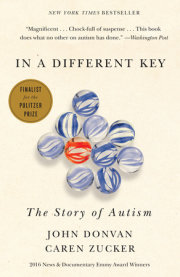9780307985675|excerpt
Donvan / IN A DIFFERENT KEY
1
Donald
In 1935, five Canadian baby girls, all sisters, edged out Niagara Falls on the list of Canada’s most popular tourist draws. That year, up to six thousand visitors each day took Route 11 into far northern Ontario for the sole purpose of gawking at the babies. By order of the provincial government, they had recently been removed from the care of their farmer parents, to be raised instead in a hurriedly built “hospital” situated not far from the family farmhouse. There they would have indoor plumbing, electricity, and a “scientific” upbringing overseen by a full-time doctor and two full-time nurses.
Three times a day, on cue, the girls were carried out to a grass-covered “play area” just a few yards from where a crowd waited for them. The audience was packed into a specially designed viewing arcade, tented and fitted with one-way screens so that the girls could never see who was making all the noise. Invariably, the moment they came into view, a warm sigh would float aloft, followed by coos, squeals, and scattered applause at the sight of history’s first surviving identical quintuplets, who had been given only hours to live the night they were born, in May of the previous year.
Exotic by virtue of their genetic rarity, the Dionne quintuplets imprinted themselves indelibly on their generation. They were a matched set, yet unmatched in the example they set of human resilience, the most famous children on earth. The future queen of England would visit them. Mae West, Clark Gable, and Bette Davis all made the trip north. So did Amelia Earhart, six weeks before her final flight, not to mention thousands of ordinary families on vacation.
All were transfixed, but never, apparently, troubled by the bizarreness, even cruelty, of the arrangement—the girls’ separation from their parents and from other children, their confinement in a setting they were allowed to leave only three times over the course of nine years, their government’s exploitation of a random biological novelty to bring tourist dollars into a depressed province. It was estimated that the public exhibition of the girls, known as Quintland, increased revenues for Ontario by $110 million over those nine years.
The family shared in some of the riches as well. By the time the girls’ father sued successfully to reunite the family, well into World War II, he was driving a Cadillac. Money had also poured in from movie deals, contracts for exclusive interviews, and a series of endorsements that put the girls’ faces in almost every kitchen in America—on calendars, bottles of Karo syrup, and boxes of Quaker Oats. For years to come, no seasonal ritual came or went—not Christmas Eve, not Halloween night, not Mother’s Day—without glowing newspaper and magazine stories catching readers up with the Dionne quints.
It was no surprise that the girls would also mean something to a little boy named Donald, who was growing up in Forest, Mississippi, a small town nearly as rural as theirs. Though only eight months older than them, Donald was already able to recite their names: Emilie, Cecile, Marie, Yvonne, and Annette.
Except that, for Donald, these were not the names of girls. They were colors inside bottles.
“Annette and Cecile make purple,” he would declare as he sketched, handling his set of paint bottles. In a sense, he had it right, insofar as his “Annette” bottle contained blue paint, and “Cecile” held red. But while his color theory was sound, his reaction to the girls was peculiar. Unlike everyone else, Donald was captivated not by the girls’ humanity or the astonishing fact of their survival but by the raw geometry of their sameness. They came in an identical set of five. Just like his bottles. But they were also different, like the paint inside his bottles. It seems to have been this paradox that caught and held his attention.
If it had only been a game he was playing—some deliberate silliness or make-believe—then what Donald called his paint bottles would never have mattered much to anyone but himself. Certainly it would not be a story worth telling so many decades later. But he was serious. Blue was Annette and red was Cecile, relentlessly and earnestly, whether Donald was drawing with crayons or talking about a candy cane. He was inflexible about this, and much else besides.
The word “yes,” for example, always had to mean one thing and one thing only: that he wanted to be hoisted up onto his dad’s shoulders. “You” was his fixed way of saying “I,” and vice versa. Some words, like “chrysanthemum,” “business,” and “trumpet vine,” he repeated endlessly, with no decipherable intention. He was once observed staring into empty space, writing letters with his fingers in the air, commenting as he went along, “Semicolon, capital, twelve, twelve, slain slain; I could put a little comma.”
The way he thought about numbers was also unique. When he was seven, an examiner asked him a question from the Binet-Simon IQ test, as it was then called: “If I were to buy four cents’ worth of candy and give the storekeeper ten cents, how much would I get back?” “I’ll draw a hexagon,” he said in reply. Internally the gears were obviously meshing, but they seemed to slip, critically, when the task was to communicate clearly with others. His was a language of hexagons and chrysanthemums, whether it made sense to others or not.
Indeed, Donald showed scant interest in the inhabitants of the outside world, and that included his parents. Of all his peculiarities, this was the most difficult for them to accept—that he never ran to his father when he came home from work, and that he almost never cried for his mother. Relatives were unable to engage him, and when Santa showed up one Christmas, in what seems to have been a calculated effort to break through to the little boy, Donald paid him no heed whatsoever.
Seemingly oblivious to the people around him, he would turn violent the instant his activities were interrupted, whether he was sketching words in the air or spinning pot lids on the floor. Over time, it became clear that he was protecting something: sameness. Pure, unadulterated routine. He could not tolerate even the slightest changes to his physical surroundings. Furniture could not be moved, walks outdoors had to retrace exactly steps already taken, and toys had to be arranged precisely as he had left them. Anything out of place would set off wild tantrums.
Of course, this meant Donald had to be able to remember the arrangements of things, and for this he relied on his astounding capacity for recall. He could watch his father put different-colored beads on a string and then reproduce the pattern without a single glance at the original. He could rebuild a tower of blocks that had been knocked over exactly as it had been, each side of each block facing in its original direction. At the age of two, having easily mastered the alphabet, he immediately learned to recite the letters in reverse. Neither was much of a challenge, since the order never changed, backward or forward.
Odder than each of these behaviors on its own was the fact that they were locked together in a distinct combination of deficits and talents. And yet this constellation of behaviors, which shaped Donald’s personality so comprehensively and dramatically, had no name. For that reason, Donald’s mother drew the only conclusion that made sense to her, relying on the only words she could think of. With regret and sorrow, she wrote a letter in which she confessed that her little boy was “hopelessly insane.” The diagnosis of “autism” had not yet been invented.
Mary Triplett, Donald’s mother, was the one who would change that. She and Donald’s father intended only to get help for their son, but in doing so, they set in motion a chain of events that would culminate in the discovery of autism in Donald, and the publication of the first internationally recognized description of the condition in a medical journal.
But before any of that could happen, Donald’s parents would first have to undo a mistake they had made early and regretted almost immediately. They had to get him back home.
The last time the three of them had been together as a family had been just over a year earlier. They had been driving south out of Forest, a journey of about an hour ahead of them—two at most. But Donald, not quite four years old in that late summer of 1937, could not have been expected to understand what an hour feels like, much less guess that when the ride ended, his mother and father would disappear from his life altogether.
He was a boy who dreaded riding on or in moving objects. Tricycles provoked in him a mortal terror. He fled from swings. But ensconced between his parents in the front seat of the Buick, Donald could lean against his mother if he wanted to. True, he had never really cried for her, never fixed his gaze on her and shared a moment of tenderness. Not once during this ride would he look up at her and smile, and she knew that.
That was the hardest thing for Mary—Donald’s utter emotional indifference to her presence. The boy beside her did not seem to care in the slightest whether she caressed or kissed or hugged him. If she were to turn away and face the open window, lost in her own thoughts, he would never cling or whimper to win back her attention. One of the most basic pleasures a parent feels—that of being loved—was completely unknown to her, even though the other young mothers in her circle took it for granted. Surely a child’s love for his mother was instinctive, the conventional order of things. And if Mary knew one thing about herself, it was that she’d always been most at home within the boundaries of the conventional, and had done surpassingly well there.
That was not to say that she was average. She had been raised to get the best out of life, with the superb advantage of being born to one of Forest’s leading families, with more money and education than most of those around her. Not that there was much competition. Forest called itself a city, but really it had always been a small rural town. Even after knocking on every door in the community in 1930, census takers hadn’t been able to count more than 3,000 souls. True, there was a lively enough downtown—a barbershop, a beauty salon, grocery and furniture stores, several churches, a courthouse, a railroad depot, and a public high school that served white children from Forest and surrounding towns.
The dropout rate at the school, however, was always a problem, as it would remain far into the future throughout Mississippi, where poverty, illiteracy, and a shorter-than-average life expectancy were the state’s enduring triple curse. Despite the presence of two strong universities in Ole Miss and archrival Mississippi State, as well as a broad talent pool of doctors, lawyers, engineers, newspapermen, and some extraordinary artists and writers, there was a cultural and political inertia—a resistance to progress, a preference for the traditional ways.
Even when the civil rights movement finally reached Mississippi in the mid-1960s, upending the status quo, the ferment came more slowly to Scott County, where Forest was located, and where “Negroes” generally had no opportunity to vote. As late as 1957, town elders pressed the Forest High School marching band to open a football game with “Dixie” instead of “The Star Spangled Banner,” which they described as the anthem of an oppressive new order. The school administration complied.
Mary was born a McCravey, granddaughter to J. R. McCravey, a founder of the Bank of Forest, which still operates today. Conservative Presbyterians, the McCraveys had little incentive to upset the social order, but her parents did have more sophisticated aspirations than raising yet another mildly educated Southern belle. They pulled Mary out of public school to send her to a private Presbyterian girls’ school fifty miles away in Jackson. A few years later, still in Jackson, she enrolled in Belhaven College, a school for Christian women.
She did well at Belhaven, where she was named business manager for the yearbook, elected senior class president, and awarded a bachelor’s degree in English. Graduate school was an option, but Mary chose to move directly into teaching, one of the careers most welcoming to the nation’s relatively few college-educated women. She joined the English department of a public high school that prepared teenagers primarily for the farming life.
The next stage for her, it was clear, would be marriage, followed by motherhood. For the time being, she would keep working, but as with any single woman her age in Forest, her proper ambition during this phase in her life—which ideally should not run for too long—was to be courted.
She didn’t have long to wait. Though not beautiful, she had an appealing confidence; her wavy bobbed hair, modest jewelry, and simple dresses signaled that she felt comfortable in her skin. And then, of course, her family owned that bank.
She had more than one suitor but settled finally for a local young man named Oliver Triplett. Known to everyone by his middle name, Beamon, he was the former mayor’s son. He was active with Boy Scouts and regularly taught Sunday school at the Presbyterian church, where his sister was the organist. The unusual thing about Beamon was that he had left home to go north to complete his law studies at Yale, then come home again to open a one-man practice in a corner office above a storefront facing the county courthouse.
Mary and Beamon exchanged vows on June 19, 1930. She was twenty-five, and he was twenty-seven. Donald was born a little more than three years later, on September 8, 1933.
They sensed nothing amiss in the beginning, but then, they had no previous experience to go by. Physically, Donald was perfectly normal; he learned to sit up and walk according to the usual timetable, and even talked a little early. A weathered family album shows a small baby and then a toddler, who does, on occasion, look directly into the camera. In one shot, taken when he was probably not yet one, his gaze appears as intently focused forward as that of his grandfather, on whose right arm he perches. In another, in which he appears to be about two, Donald stands alone in the family garden, his body turned away from the camera, his hands occupied with some sort of toy vehicle. But his face and eyes are turned toward the camera, with a smile that seems aimed at the photographer, as though an instant earlier he had heard his name called, and was now glancing back over his shoulder to see who was there.
The album shows the moments of connection becoming less frequent as Donald gets older. He smiles less, and a discomfort creeps in—a discomfort in being held, or made to sit still, or compelled to look “natural” with the parents and aunts and grandparents who stand near him in billowing blouses, bow ties, straw hats, and suspenders. In nearly every frame, everyone grins big and focuses their attention on the camera—everyone but Donald, who peers off in random directions, his bare arms and legs limp.
Mary had to admit to herself that Donald was not “normal,” whatever normal meant. Neither, any longer, was Mary’s life as his mother. All her hours now belonged to Donald, even as he reached an age when children start to become more self-sufficient. Well into his third year he still could not feed himself, so she was at his side at every meal, handing him the cup, raising the spoon to his mouth, cajoling him to eat. He had no common sense about danger, yet he grew ever more competent at putting himself into dangerous situations. He could figure out the latch on a second-floor window, for example, or find his way outside and to the middle of the street, yet he was oblivious to the possibility that he might fall out the window or be mowed down by a car. He needed a guardian angel, and his mother filled the position, following him on his mysterious rounds from room to room during all his waking hours.
This required an inexhaustible supply of energy, yet somehow Mary found new ways to keep trying to reverse whatever was wrong with him. She talked to him, although it was always a one-way conversation. Yet she knew Donald must be hearing her, because he demonstrated an astounding gift for recalling what he had heard. She saw this in 1934 when, around Christmas, she started singing carols in the house. Suddenly Donald, only fifteen months old, began singing them too, word for word. Soon after, he memorized the twenty-five questions and answers of the Presbyterian catechism.
Mary also dedicated herself to learning her son’s many elaborate rituals. His extreme need for sameness made him violently inflexible about a series of routines of his own invention. Many of these were verbal, such as an incantation at breakfast every morning that went like this:
“Say ‘Eat it or I won’t give you tomatoes, but if I don’t eat it I will give you tomatoes.’ ” It made no obvious sense, but that wasn’t important. If Mary didn’t say the words, exactly as instructed, Donald would scream, every muscle visibly strained in agony. Thus, Mary became his partner in this strange performance, taking on a series of roles that kept her perpetually by his side. In a world teeming with variables, she was the one constant in his life, reliably and relentlessly there.
And so, as the three of them motored south that day on Mississippi 35, perhaps Mary let herself think that her presence next to Donald helped him relax. Perhaps, on a certain level, she was right. Inside the car, she represented the familiar. Everything outside would have hurtled at Donald in a raucous rush of unpredictability—the very thing that rattled him most. The passing sights and sounds that would go unremarked upon by most of us—the ugly belch of a tractor churning smoke in a field; a flapping mass of laundry on a clothesline; the unexpected sound of a car radio crackling from the window of an oncoming car; not to mention the rocking and rumble of the car he was in—would have unfolded in a startling, spontaneous riot, faster than Donald’s mind could make sense of it. It’s easy to imagine him leaning into his mother’s side in the face of this onslaught, not necessarily to get her attention, but because she served as a constant in his life. She was the same as always, exactly how he needed things to be.
But Donald was leaving her, and his father too. The three of them were headed to a little town called Sanatorium, Mississippi, to a facility known as the Preventorium, established in 1930. Located on a small rise, it was a curious statement of a building, unexpectedly handsome and bold among the pines. On its driveway side, six huge white columns supported a high roof, throwing shade over the steps and veranda. Inside, the Preventorium’s rooms and corridors were arranged to replicate the shape of a double crucifix.
The Preventorium housed exclusively white children between the ages of four and eleven, up to fifty at any one time, each committed to the care of the state of Mississippi to reside, parents were promised, “under constant expert medical supervision.” In the most literal sense of the word, these kids were “institutionalized.” Their number would soon increase by one. Since Donald was still only three, the state would be making an exception in taking him, but that had been worked out in advance.
Goodbyes at the Preventorium were managed briskly, with little time for clinging or tears. One child resident of that era, Cecile Snider, recalls that even her mother did not explain why she had been brought to this elegant dormitory that looked vaguely like a red-walled Greek temple. Cecile was six and had followed her mother trustingly between the two huge white pillars that framed the entrance. Two hours later, when her mother left without her, Cecile did not quite comprehend that she was now on her own and would not see her mother for months. One of the nurses took possession of her prized Shirley Temple doll—which she would never see again—and directed her instead to the shelves of communal toys, games, and books. Another nurse took away the clothes and shoes she had worn from home. From then on, she would dress in short white bloomers and a white sleeveless top and go barefoot, like all the children at the Preventorium. This separation would haunt her well into adulthood.
Donald, however, already appeared emotionally separated from his family and anyone else who happened to be around. He had a habit, any time he entered a new setting, of ignoring any people present and making straight for whatever inanimate objects might catch his eye: paper clips or seat cushions or an ashtray—especially anything that could be set spinning. Wholly engaged by these new objects, Donald would have missed the mood of the moment, not seen the tension in his parents’ eyes as they knelt down for their final goodbye. If anything, he might have been slightly irritated by the interruption.
Mary and Beamon watched the nurse take Donald by the hand and lead him down the hall, where there was a uniform waiting for him, still crisp from the laundry. Then they turned away, passing once again through the pillars out front, and headed for the car. There could not have been much to say on the long ride home.
Copyright © 2016 by John Donvan. All rights reserved. No part of this excerpt may be reproduced or reprinted without permission in writing from the publisher.












